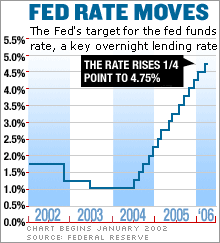|
A hot time in the old economy
High fuel prices and rising interest rates were expected to cool things off, but the most recent numbers show no signs of that.
NEW YORK (CNNMoney.com) - High energy prices generally aren't the fuel of a hot economy. But you can't prove it by recent economic numbers. Friday, the nation's gross domestic product posted its fastest pace of gain in more than two years, growing at a 4.8 percent annual rate, despite high oil prices in the period. And early estimates from economists is that growth will stay hot, perhaps close to 4 percent, even with oil prices setting records and remaining above the previously scary $70 a barrel mark.
The strong growth in the face of higher oil prices is raising expectations that the Federal Reserve will hike short-term interest rates at both its May and June meetings, instead of just one more time. While a May hike has been widely expected for months, there's been debate about whether another hike in June is necessary - a debate that seemed to tip to expectations of no increase when the Fed last week released the minutes of its most recent meeting in March. Chairman Ben Bernanke testified before Congress that record high oil prices remain a concern that could pose a risk to both economic growth and the inflation outlook. A number of economists say much of the first-quarter strength can be explained away by saying the economy was playing catch-up from weak fourth-quarter growth of 1.7 percent annual growth following the hurricanes, coupled with a boost from the warmest January on record. But with a number of March economic numbers such as home sales and durable goods orders showing much better-than-expected strength heading into the second quarter, it's not as easy for economists - or Fed policymakers - to discount a big first-quarter gain. Drew Matus, senior economist at Lehman Brothers, is forecasting 3.8 percent GDP growth in the second quarter, a pace he said "certainly is running too hot, relatively to where we should be. There's a sweet spot in the economy where you have growth but inflation doesn't take hold. That's not that sweet spot." Because of that Lehman is forecasting a fed funds rate of 5.5 percent, representing three more quarter-percentage point hikes, by the end of September. "The Fed will not stop raising rates if the economy is growing at 4 percent or better and adding 200,000 jobs a month, which is what we're looking at," he said. "In that scenario, without a slowdown, the Fed will have to keep raising rates, and 6 percent is a reasonable realm." What slowdown?
All of which leaves many economists scratching their heads as they look for the slowdown they've been predicting. "My guess is things will cool abruptly; the question is do they do it by June 29," said David Wyss, chief economist for Standard & Poor's, referring to the date of the Fed meeting in June. Wyss is still forecasting the Fed will stop raising rates after taking the fed funds rate up another quarter percentage point to 5 percent on May 10. But he concedes it's looking less and less likely he'll be able to stick with that forecast. "The second quarter is shaping up to be stronger than expected," said Wyss, who is now forecasting 4 percent growth in that quarter. Even recent energy price increases don't seem to be slowing down the economy, he said. "Common sense says consumers have to stop spending money at some point. But consumers haven't shown much common sense lately, despite griping about gas prices," Wyss added. Jerry Castellini, president and chief investment officer for CastleArk Management, a Chicago bond and stock portfolio manager, argues economists have continually overestimated how much high energy prices will slow the economy. He said that stocks, corporate profits and consumer spending should be able to keep posting gains, even if oil prices stay at or above $70 a barrel, assuming there isn't some kind of shock to take oil significantly higher. "It appears with the employment gains, it's not enough to put us into the real hard slowdown," he said. He argues changes in the economy make the impact of energy price increases a lot less than in past oil shocks of the 1970's or 1980's. "You have an economy that is service based, not manufacturing based, today," he said. "Economists were arguing we'd have problems when oil went from $26 to $36 a barrel. We've doubled since then and kept growing. That shows you the lack of vulnerability we have." Still even Castellini is projecting that energy prices will slow the economy enough in the second half that the Fed will be able to stop raising rates after the June 29 meeting. And the March economic numbers causing so much worry in the market will be ancient history for both the Fed and economists by the end of June, when two more months of readings on such key measures as consumer prices and job creation will be considered. And it's not clear how much of the strength being shown in March readings really reflect the run-up in energy prices seen over the last month. The AAA showed the average price for a gallon of regular unleaded at $2.501 on March 26, making March seem like the good old days as prices now move toward the $3 a gallon threshold. So a month from now, when the gasoline prices start to be seen in the April numbers, all the talk could be about a cooling economy, not a hot one, and a June hike by the Fed could again be off the table. But it's very much in play right now. ------------------------------------------------ For more on the economy and what it means to you and the markets, click here.
For a special report, "Eyes on the Fed," click here. |
|


